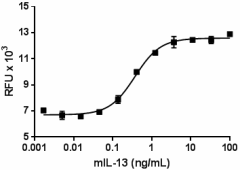- Regulatory Status
- RUO
- Other Names
- P600, IL-13, IL1

-

Recombinant mouse IL-13 induces the proliferation of TF-1 cell in a dose-dependent manner. The ED50 for this effect is 0.3 - 1.5 ng/mL.
| Cat # | Size | Price | Quantity Check Availability | ||
|---|---|---|---|---|---|
| 575902 | 10 µg | $206.00 | |||
| 575904 | 25 µg | $411.00 | |||
| 575906 | 100 µg | $1202.00 | |||
| 575908 | 500 µg | $2929.00 | |||
Mouse IL-13 was initially cloned from cDNA libraries of activated T cells and was designated as P600. IL-13 is an immunoregulatory cytokine secreted predominantly by activated T(H)2 cells, and it is a key mediator in the pathogenesis of allergic inflammation. IL-13 shares many functional properties with IL-4, and they share a common receptor subunit, the alpha subunit of the IL-4 receptor (IL-4Ralpha). IL-13 mediates its effects by interacting with a complex receptor system comprised of IL-4Ralpha and two IL-13 binding proteins, IL-13Ralpha1 and IL-13Ralpha2. Ligation of the IL-13 receptor complex results in signaling via the insulin receptor substrate (IRS)-1 and 2 and STAT-6 pathways. Interleukin-13 (IL-13), like IL-4, is a cytokine produced by T(H)2 type helper T cells in response to signaling through the T cell antigen receptor and by mast cells and basophils upon cross-linkage of the high-affinity receptor for immunoglobulin E (IgE). IL-13 has been implicated in airway hypersensitivity and mucus hypersecretion, inflammatory bowel disease, and parasitic nematode expulsion.
Product Details
- Source
- Mouse IL-13, amino acids Ser26-Phe131 (Accession # NM_008355), was expressed in E. coli.
- Molecular Mass
- The 106 amino acid recombinant protein has a predicted molecular mass of 11,677 Da. The DTT-reduced protein migrates at approximately 9kDa and the non-reduced protein migrates at approximately 8kDa by SDS-PAGE. The N-terminal amino acid is Serine.
- Purity
- Purity is >98%, as determined by Coomassie stained SDS-PAGE.
- Formulation
- 0.22 µm filtered protein solution is in 10mM NaH2PO4, 150mM NaCl, pH 7.2.
- Endotoxin Level
- Endotoxin level is <0.1 EU/µg (<0.01ng/µg) protein as determined by the LAL method.
- Concentration
- 10 and 25 µg sizes are bottled at 200 µg/mL. 100 µg size and larger sizes are lot-specific and bottled at the concentration indicated on the vial. To obtain lot-specific concentration and expiration, please enter the lot number in our Certificate of Analysis online tool.
- Storage & Handling
- Unopened vial can be stored between 2°C and 8°C for up to 2 weeks, at -20°C for up to six months, or at -70°C or colder until the expiration date. For maximum results, quick spin vial prior to opening. The protein can be aliquoted and stored at -20°C or colder. Stock solutions can also be prepared at 50 - 100 µg/mL in appropriate sterile buffer, carrier protein such as 0.2 - 1% BSA or HSA can be added when preparing the stock solution. Aliquots can be stored between 2°C and 8°C for up to one week and stored at -20°C or colder for up to 3 months. Avoid repeated freeze/thaw cycles.
- Activity
- Recombinant mouse IL-13 induces the proliferation of TF-1 cell in a dose-dependent manner. The ED50 for this effect is 0.3 - 1.5 ng/mL.
- Application
-
Bioassay
- Application Notes
-
BioLegend carrier-free recombinant proteins provided in liquid format are shipped on blue-ice. Our comparison testing data indicates that when handled and stored as recommended, the liquid format has equal or better stability and shelf-life compared to commercially available lyophilized proteins after reconstitution. Our liquid proteins are verified in-house to maintain activity after shipping on blue ice and are backed by our 100% satisfaction guarantee. If you have any concerns, contact us at tech@biolegend.com.
- Product Citations
-
Antigen Details
- Structure
- Cytokine
- Distribution
-
IL-13 is secreted by activated T cells, Th2 cells, basophils, mast cells, activated eosinophils and NK cells.
- Function
- IL-13 modulates human monocytes/macrophages and B cells. IL-13 induces an increase of MHC class II expression in human monocytes/macrophages, and direct inhibition of inflammatory cytokines such as TNF-α and IL-1β.
- Interaction
- IL-13 receptors are expressed on human B cells, basophils, eosinophils, mast cells, endothelial cells, fibroblasts, monocytes, macrophages, respiratory epithelial cells, and smooth muscle cells.
- Ligand/Receptor
- IL-4Ralpha, IL-13Ralpha1, and IL-13Ralpha2
- Biology Area
- Cell Biology, Immunology, Neuroinflammation, Neuroscience
- Molecular Family
- Cytokines/Chemokines
- Antigen References
-
1. Brown J, et al. J. Immunol. 142:679-687 1989.
2. McKenzie ANJ, et al. P. Natl. Acad. Sci. USA 90:3735-3739 1993.
3. Papasavvas E, et al. J. Immunol. 175:5532-5540 2005.
4. Kelly-Wellch, et al. Science Signaling 293:2005.
5. Hershey GK J Allergy Clin Immunol 111:677-690 2003.
6. Harris J, et al. Immunity 27:505-517 2007.
7. LaPorte SL, et al. Cell 132:259-272 2008. - Gene ID
- 16163 View all products for this Gene ID
- UniProt
- View information about IL-13 on UniProt.org
